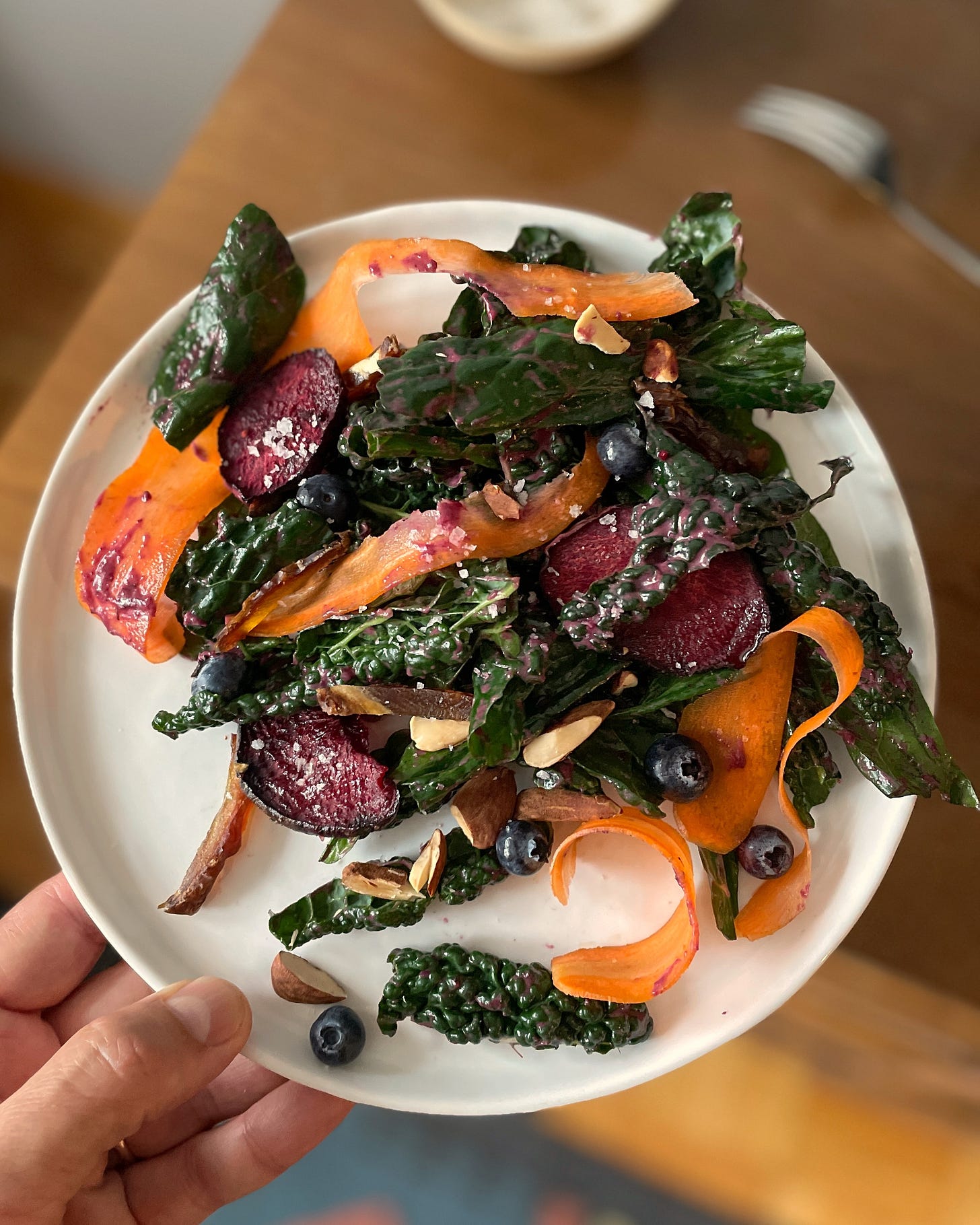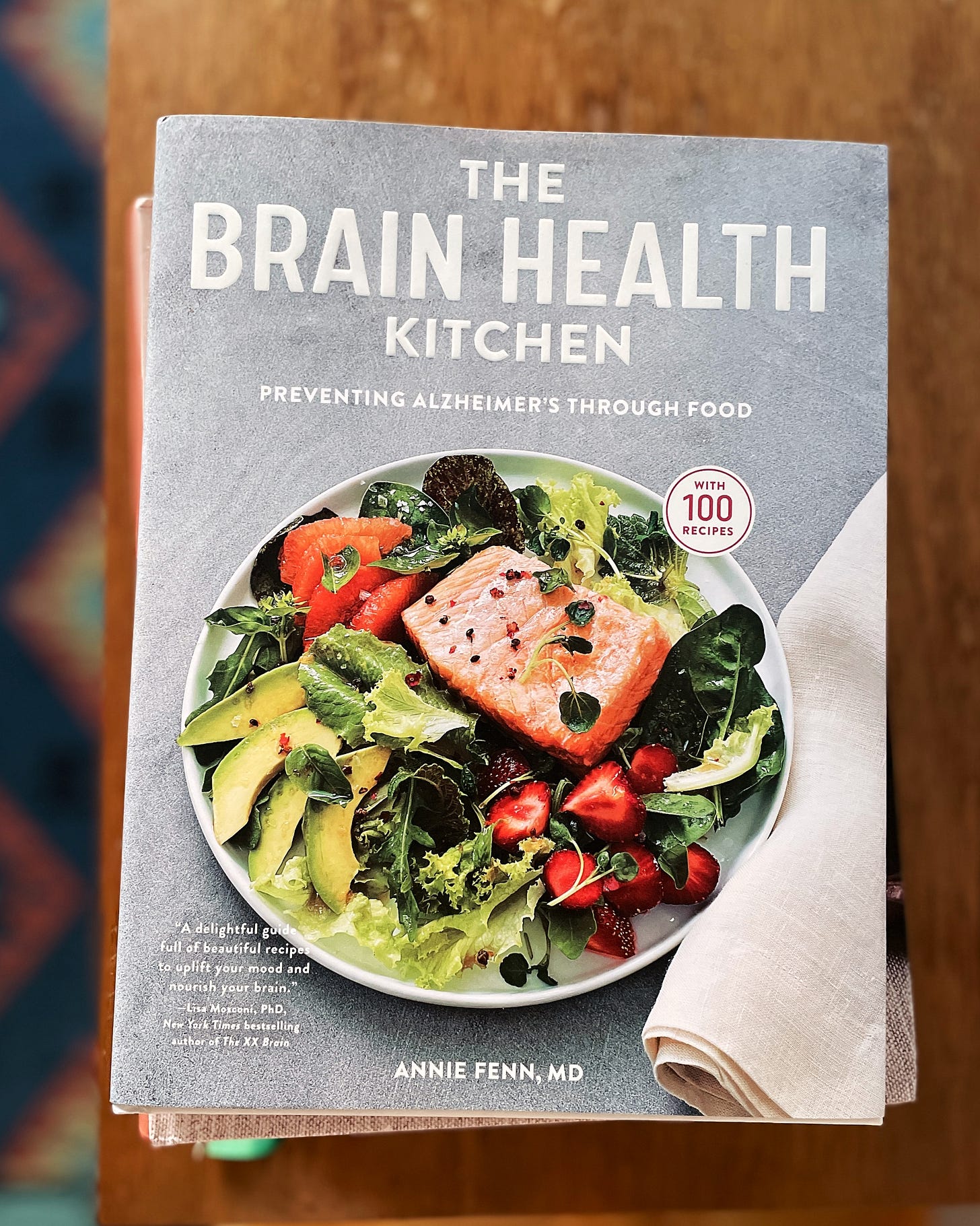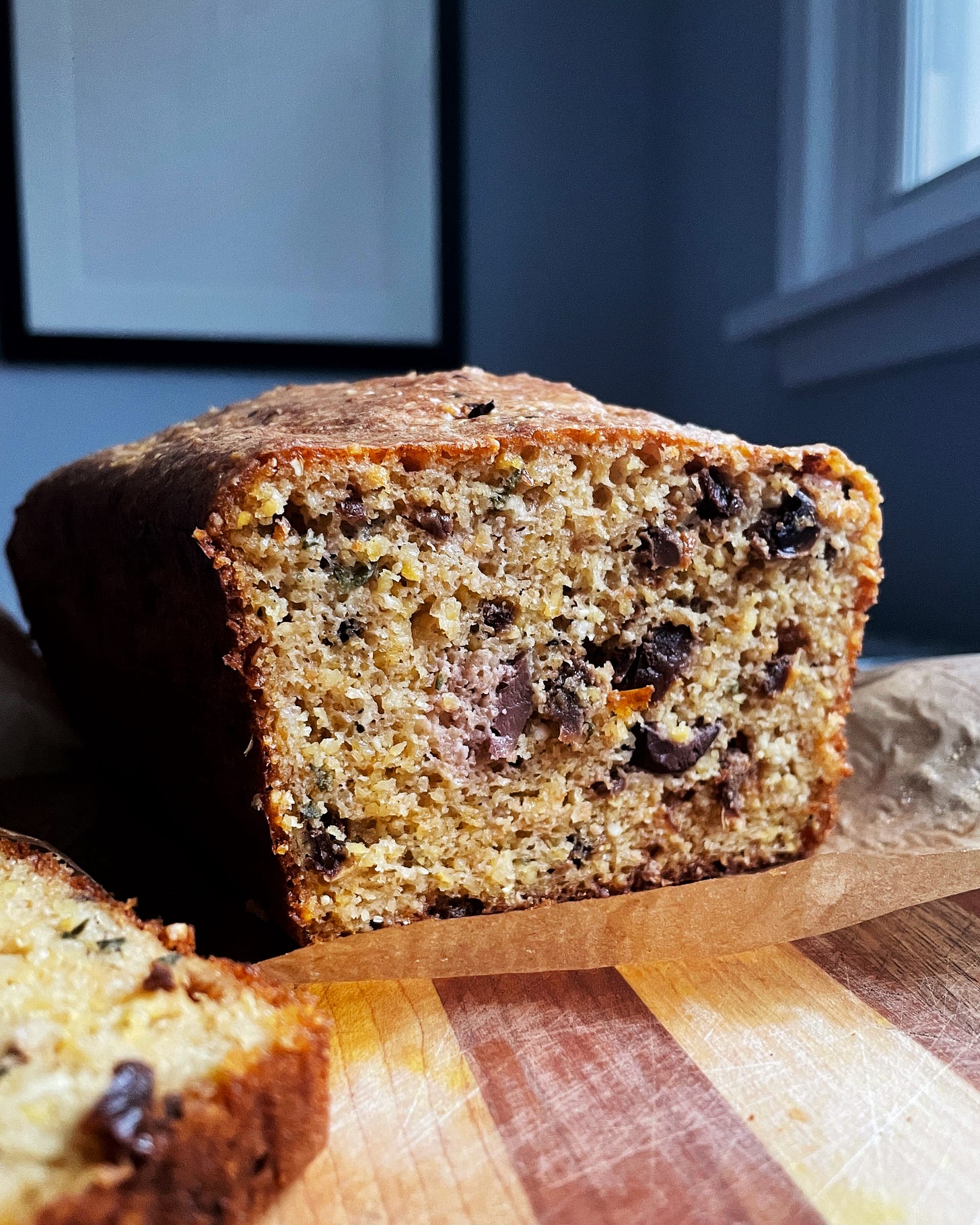Recipes for Nourishing Your Brain
Speaking with Dr. Annie Fenn, author of The Brain Health Kitchen
While I’m not much of a New Year’s resolutions person, this year, facing the fact that I’m 41 years old and undeniably in the thick of middle age, I decided that one of the organs I want to make sure I’m properly feeding is my brain. I’m sure you all have experience witnessing the trauma of dementia — it’s in my family as well. You may also know that while there’s still no cure for Alzheimers, there’s mounting evidence that what we eat can significantly help to mitigate the risk.
Physician and chef
is a leader in this space and has written a food-loving, comprehensive yet very accessible cookbook called The Brain Health Kitchen. It’s organized by ten brain-nourishing food groups, most of which are already probably part of your regular meals if you’re a subscriber to this newsletter, and it’s full of enticing and inventive, weeknight-friendly recipes.I’ll admit that I’m easily overwhelmed and intimidated by medical studies, nutritional data, science speak, and the cacophony of often conflicting messaging when I come across this stuff in the news. But reading The Brain Health Kitchen is a bit of a balm. It has a clear, welcoming voice that cuts through the noise without stoking fear, pushing extremes, or doing any finger-wagging judgment. Dr. Fenn is practical about the role of food, pleasure, and joy in our day-to-day lives, and leads by example with over a hundred delicious recipes.
But she also doesn’t shy from the fact that caring for your brain is really a long-term commitment — Alzheimers disease can begin up to 30 years before symptoms appear, so teaching people how to establish neuroprotective eating habits early in life is the driving force behind her advocacy.
I’ve cooked through a number of Dr. Fenn’s recipes, from an olive-studded savory quick bread to a warm blueberry vinaigrette, which got drizzled over an excellent kale salad made extra filling with meaty discs of roasted beets and crunchy toasted almonds, and I can vouch that The Brain Health Kitchen is just as thorough in its summary of up-to-date brain health and Alzheimers prevention research, as it is brimming with tips that will change how you cook and keeper recipes.
I relished the opportunity to speak with such a knowledgable expert and hope you enjoy the Q&A below! And I can’t stress enough what a resource her newsletter
is, for delicious recipes and just as importantly if you are interested in knowing what’s going on in this realm of research.A quick reminder…
The revised and updated second edition of Veggie Burgers Every Which Way will be publishing in just a few months — but it’s available for preorder now! And as you know, those who preorder will be the very first to get their copies. Stay tuned for events and other activities to celebrate the release.
Recipes for Nourishing Your Brain
A Q&A with Author & Chef Dr. Annie Fenn
I think a lot of people reading this will be thrilled to find some of their favorite foods featured — like nuts, berries, beans, coffee, and whole grains. How did you come to identify these specific foods, and what guided you as you determined the scope of the cookbook?
The brain-healthy foods are also the most delicious, it’s true! Which makes eating for brain health easy, doable, and totally enjoyable. When I started writing the book back in 2017, I thought I was writing a book about the MIND diet study (MIND stands for Mediterranean-DASH Intervention for Neurodegenerative Delay), published in 2015. The MIND diet elegantly described 10 brain-healthy food groups and 5 food groups to limit or avoid. Study participants who followed the guidelines most closely reduced dementia risk by as much as 53%. This was astounding! We still don’t have a cure or a viable treatment for Alzheimer’s, and now this nutritional intervention was slashing risk in half.
Around the time the MIND diet came out, my mom was diagnosed with Alzheimer’s, and I did a deep dive into all the nutritional interventions targeted at prevention. I created the Brain Health Kitchen cooking school to show people how to enjoy the foods in the MIND diet and learn how to protect their brains from Alzheimer’s. In the book, I wanted to give people the same experience as coming to cooking class—the tools needed to choose the right foods, create amazing meals using gentle cooking techniques, all while falling in love with this way of eating and learning about how to thrive with age.
As the study of eating to prevent Alzheimer’s evolved, I ended up modifying the MIND guidelines slightly. There are more servings of berries, leafy greens, and vegetables, for example, because of data showing how these flavonoid-rich foods (plant pigments in fruits and vegetables that block oxidative stress in the brain) can also reduce Alzheimer’s risk by half. And, I’m more specific about the types of vegetables to include in a brain-healthy diet. I added mushrooms as an honorary vegetable (as we all know they are fungi) due to recent studies out of Northern Italy, China, and Singapore that show healthy older adults have about 40% less dementia if they eat two servings of mushrooms a week.
The Brain Health Kitchen Guidelines, then, are a reflection of the hundreds of data points in the scientific literature pertaining to what to eat to protect the brain. I take into account the Mediterranean diet studies, data from Blue Zones, information about stroke reduction from whole-food plant-based studies, and what we’ve learned about the gut-brain connection. I added a daily serving of fermented food to my brain health pyramid based on a landmark study published out of Stanford regarding how this shapes the gut microbiome.
Your book was my introduction to the Blue Zones, which are the five places on the planet where people live the longest. I know that we inhabit a global world, where it's possible to adopt eating habits from far-flung places no matter where you may live, but how might local and seasonal food figure in? Is your immediate environment a factor here?
The Blue Zones really do show us that while it’s important to have a brain-healthy diet, it’s equally important to have a lifestyle that supports your health. And even though Blue Zones are distinct geographic areas, it’s possible to create your own Blue Zone wherever you are.
In the book, I go into how to create your own brain health pyramid based on the foods you love, what you like to cook, and what makes sense for who you are, your ethnic background, and how food connects you to people and ancestors. This is the concept of “fit” that’s one of my 4F’s of brain-healthy food. For example, you may read that the Mediterranean diet has tremendous health benefits. All true! It’s also the most studied so it benefits from a bias in the research towards what is primarily a white person’s way of eating. There are other traditional diets, too, such as the African-American, Latin-American, and Asian Heritage dietary patterns, that may make more sense for an individual. If studied as extensively as the Medi diet, these would probably yield the same brain-healthy accolades.
Finding a good fit also means seeking out local and seasonal foods. These are likely to be more nutrient dense, not to mention more budget-friendly. In all the brain-protective diets studied, avoiding ultra processed foods translates to measurable brain health gains. For example, reducing just 10% of the ultra processed food in the diet yields 30% reduced dementia risk. Sometimes you have to be strategic and intentional about ridding these foods from your food environment, like your home, car, and workspace.

You write, "Wherever you find dementia-free, long-living people, beans are on the menu." Music to my ears! This made me think of the enduring popularity of elimination diets — where beans, grains, and even nightshades sometimes come out as bad guys. How does one reconcile brain-healthy eating with eating plans that might be seen to be at odds with it?
I am a big fan of the legume food family! And I am not a fan of elimination diets in general. As a physician, and now as a culinary instructor, I hear from people all the time that say they can’t eat an entire food group. While allergies and food sensitivities are a real thing, mostly this reflects discomfort in digesting foods that have been neglected in a more processed, American way of eating.
Many of the foods that have been demonized in modern culture—beans, grains, nightshades—are actually anti-inflammatory foods teeming with brain-specific nutrients like flavonoids and fiber. (These are 2 more of my 4F’s of brain-healthy food.) When you examine the science, these foods are key ingredients for successful aging.
One problem with eliminating entire food groups is that your brain loses out on micronutrients it needs to thrive. Another stems from what we know about the gut microbiome: the trillions of gut microbiota within us reflect the diversity of our diets. Feed these microbes a wide variety of food, including a lot of fiber-rich plant foods, and they will increase in numbers and unique species. In return, they produce substances that cross the blood brain barrier (like neurotransmitters and short chain fatty acids) that directly contribute to short term brain health (ie your mental health) and long term brain health (your risk for Alzheimer’s or another dementia).
I love the “science bites” scattered through the book, and one of my favorite ones focuses on za'atar. You spotlight it as being particularly beneficial from a brain-health perspective because each ingredient —the sesame, sumac, and oregano — has important and unique nutritional properties. Are there other easy, flavorful garnishes and sprinkles that are similarly beneficial?
I also love dukkah, a nut, seed and spice mix originating in Egypt. I make mine with toasted hazelnuts, sesame seeds, and crushed cumin and coriander seeds. Hazelnuts are one of the brain-healthiest nuts—full of monounsaturated fats and a good dose of vitamin E. Walnut Parm is another favorite sprinkle. You make it by pulsing walnuts, nutritional yeast, miso paste, and garlic in a food processor until crumbly. Use it wherever you’d use Parmesan cheese, or atop roasted vegetables, avocado toast, and zucchini noodles. I also fold it into turkey burgers and meatballs.
What have been the biggest breakthroughs with your patients and students?
Healthy food is finally breaking out of its former lackluster stereotype. It’s way more delicious than it was even a decade ago. I come to this space from a love of food. A brain-healthy diet has to be your favorite, most satisfying and interesting way to eat. Thanks to food people like you who create recipes that help people fall in love with beans and oatmeal and unsung vegetables, healthy eating is more fun and accessible. Even my neighborhood diner in Jackson, Wyoming serves a fantastic falafel burger that you can get as a salad on local greens.
Another breakthrough is the growing awareness around brain health. When I first started speaking to groups about preventing Alzheimer’s through food back in 2015, there were a lot of blank stares coming from the audience. Now just about everyone I speak with can name a handful of brain-healthy foods (Olive oil! Salmon! Blueberries!). This, in part, is because the number of people living with Alzheimer’s is steadily rising, so more of us are getting personally impacted by the disease. And with the baby boomer generation entering older age groups, there’s this determination to age as successfully as possible.
Alzheimer’s disease starts up to 30 years before symptoms start. That means what we eat now really determines how the brain ages. We need a steady infusion of neuroprotective foods to keep our brains in tip-top shape. My job is to make eating this way as fun, easy, and delicious as possible.
Check out The Brain Health Kitchen on Bookshop or Amazon, and follow Dr. Annie Fenn on her Substack newsletter
or Instagram.






